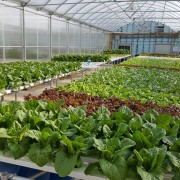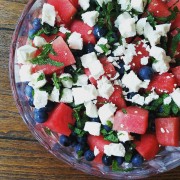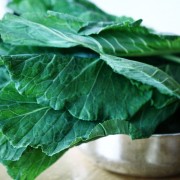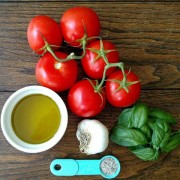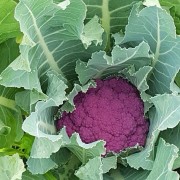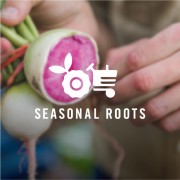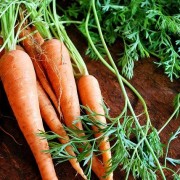Tomāto. Tomăto. No matter how you say it, there’s no denying that summer has arrived once vine-ripe tomatoes begin to grace your garden, local farmers’ markets, and your Seasonal Roots basket. I grew up in a family that was dedicated to summer gardening, so I learned to appreciate and love a homegrown red, ripe tomato from an early age. Whether we were eating them by the slice or baked into a tomato pie, it wasn’t a complete summertime meal unless a tomato was on the table.
In addition to tasting delicious, tomatoes offer a wide range of health benefits. They are an excellent source of vitamin C, vitamin A, potassium, and fiber. Tomatoes are also high in lycopene, which is a powerful antioxidant that works with other vitamins and minerals to aid in disease prevention.
Here are more fun facts about the health promoting nutrition of tomatoes:
- Lycopene is well known as a preventer of prostate cancer, which makes tomatoes high on the healthy food list for men.
- Lycopene is not just important for men. It also helps to protect the cells in our bodies from damage.
- Studies in humans have shown that lycopene is protective against a variety of cancers including prostate of course, but also colorectal, breast, lung, endometrial, pancreatic, bladder, cervical and skin cancers.
- Lycopene has also been shown to help prevent heart disease and may slow the development of cataracts and macular degeneration, an age related vision problem that can lead to blindness.
- The vitamin B6, niacin, potassium and folate found in abundance in tomatoes are potent protectors against heart disease.
- Niacin can lower high cholesterol levels and potassium has been shown to lower high blood pressure and to reduce the risk of heart disease.
- Vitamin B6 and folate also work to convert the homocysteine in our bodies into harmless molecules. High levels of homocysteine are associated with an increased risk of heart attack and stroke.
- The fiber in tomatoes also helps lower cholesterol levels, helps prevent colon cancer and helps to keep blood sugars at a low level.
- Tomatoes are a source of riboflavin which has been shown to be helpful for migraine sufferers by reducing the frequency of their headaches.
- A helpful note about tomato nutrition: lycopene is actually more available to the body when tomatoes are cooked, so cooked tomatoes are just as nutritious for you as raw.
This Raw Tomato Sauce is one of my favorite summertime recipes. With just a few simple ingredients (tomatoes, garlic, basil, olive oil, salt and pepper) and less than 10 minutes, you can prepare this healthy and versatile “sauce” to enjoy over pasta, as a bruschetta topping, or alongside your favorite pizza pie. Just chop, stir, and let the ingredients take over.

Raw Tomato Sauce
Ingredients:
4 large tomatoes
4 cloves garlic, minced
6 fresh basil leaves, slivered
1/3 cup olive oil
1 teaspoon salt
Ground black pepper, to taste
Directions:
To make, chop tomatoes and place (with juices) into a large bowl. Add garlic, 3 basil leaves, olive oil, salt, and pepper. Stir until well blended, cover, and let sit at room temperature for up to 10 hours before serving (10 hours isn’t necessary, but the longer the better). Sprinkle with the remaining basil and serve.

Raw Tomato Sauce served over fresh Zucchini Noodles
Here are a few more ways to add the benefits of fresh summer tomatoes to your diet every day:
- Add fresh tomatoes to your favorite soup or stew.
- Try a salad of sliced sweet tomatoes, basil leaves and sliced mozzarella cheese. Just sprinkle with salt and pepper and drizzle with a high quality olive oil for a tasty treat.
- Eat them raw, just like an apple, for a healthy snack.
- Add chopped raw tomatoes to dips like guacamole and hummus for color and added nutrition.
Sarah Young is a wife, mother of three, Certified Health Education Specialist, and healthy living advocate. She has a background in Dietetics and a B.S. in Health, Fitness, and Recreational Resources with a concentration in Health Promotion. She is also a writer for several local and online publications, an ambassador for the Jamie Oliver Food Foundation, and a health contributor for ABC 7 News/WJLA. In her spare time, she enjoys running, hiking, gardening, and spending time with her family and their dog, Maple.

